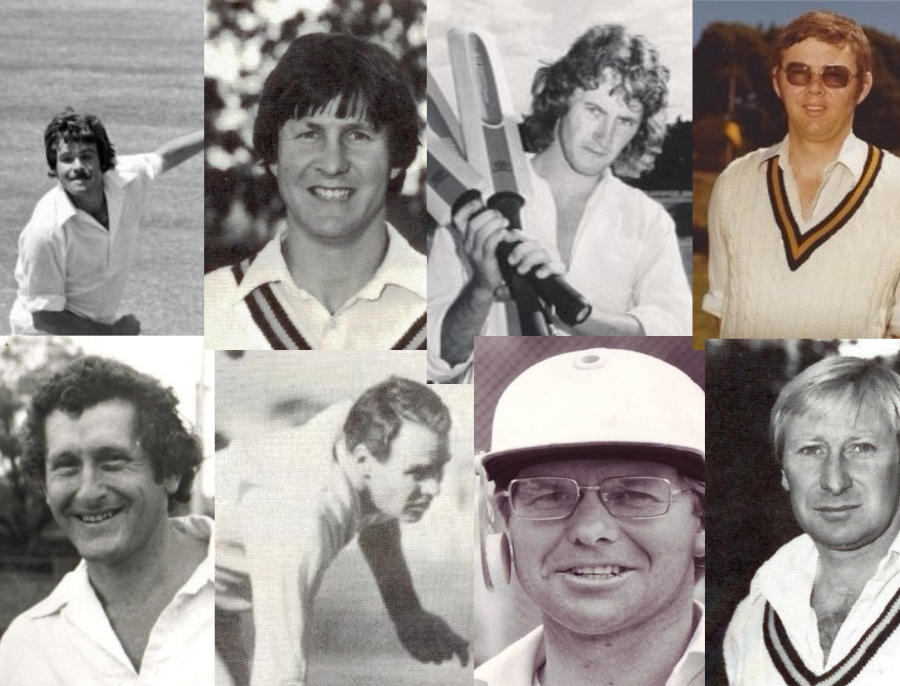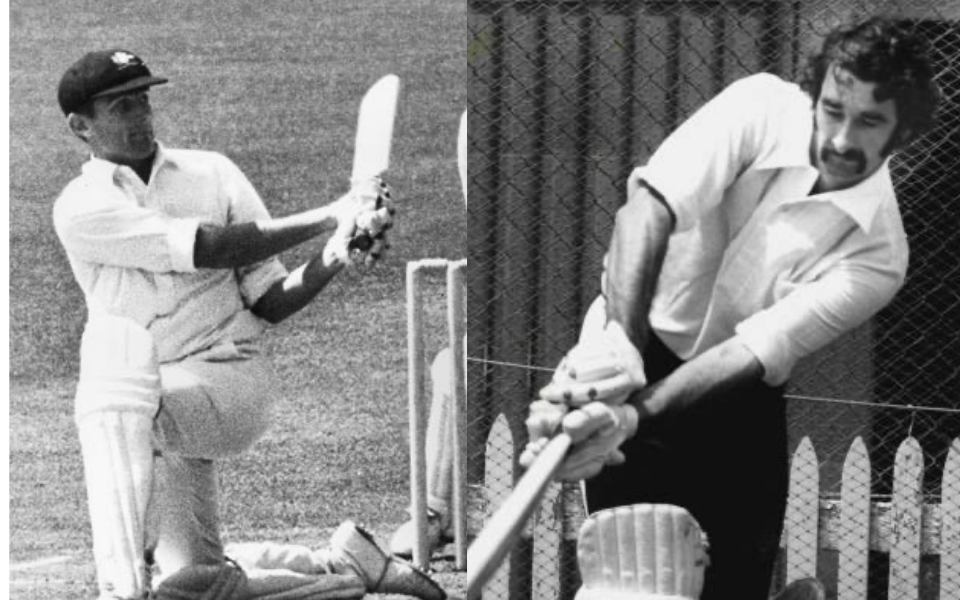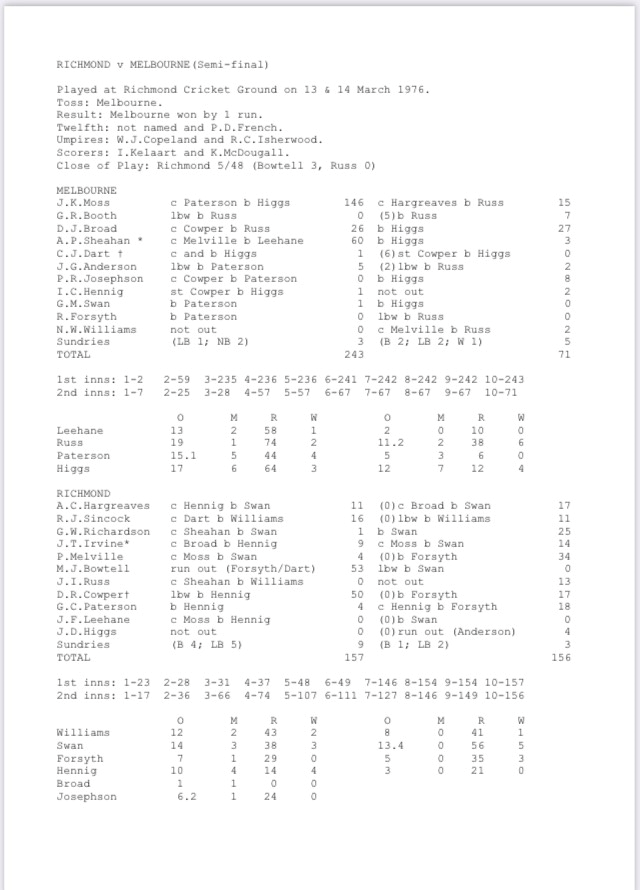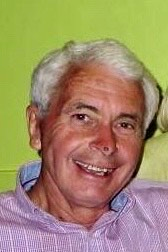Richmond Cricket Club v Melbourne Cricket Club semi-final at Punt Road March 1976
Tony Hargreaves | February 09, 2024

Richmond players from left to right
Top - Jim Higgs, Geoff Richardson, Paul Melville, John Leehane
Bottom - David Cowper, Graeme Paterson, Russell Sincock, Jeff Russ
There have been few more intense, dramatic, or competitive Melbourne club cricket finals than the District (now Premier) Cricket Semi-Final played between Richmond and Melbourne at the Punt Road Oval in 1976.
Richmond had finished the 1975-76 season well clear on top of the Ladder and had only to avoid defeat to progress to the Grand Final.
A draw - or a tie - was sufficient.
But Melbourne had no choice, it HAD to win!
The four innings’ Semi-Final, played over three days, came down to the last ball of the match - in near darkness at the Punt Road Oval - with Richmond needing only a single to tie the game and to progress to the Grand Final.
At 6:50pm on the third day, Richmond’s (and Australian Test team) number 11, Jim Higgs, was run out by centimetres - scampering for the equalising run which would have seen his team through.
The Richmond team included Australian players, Jock Irvine (Captain) and Jim Higgs - plus Victorian State players, young tyro, Paul Melville; the experienced Russell Sincock; Geoff Richardson (who scored 202 against a Queensland State attack led by Jeff Thomson); fast bowler, John Leehane (who later led Victoria to a famous Sheffield Shield victory) and wicket-keeper, David Cowper, whose brother, Bob Cowper became the first Test player to score a triple-century on Australian soil when he scored 307 against England in 1965-66 at Melbourne.
The Melbourne team included Australian Test batsmen, Paul Sheahan and Jeff Moss (each of whom scored First Class double centuries) - plus Victorian State batsmen, David “Sammy” Broad; John Anderson and Charlie Dart.
Broad was renowned for top scoring in his debut First Class innings for Victoria when he scored 26 in a Victorian team total of 9 declared for 44 on the MCG against the might of a fearsome West Australian attack led by Denis Lillee who took 4 for 15 and Mick Malone 5 for 25.
On paper, Richmond looked the stronger side - with a better-performed bowling attack and a deeper batting line-up.
It was a star-studded Semi-Final!
On a sweltering first morning, with the Punt Road wicket rolled to perfection, Melbourne skipper, Paul Sheahan, won the toss and batted.
It was no time before the Demons lost its first wicket, when opening batsman, Greg Booth, was adjudged LBW to Richmond’s aggressive opening bowler Jeff Russ, for 0 in the second over of the game.
This brought Victorian batsman, David Broad, to the crease and, with Moss, he set about a long partnership.
However, on 26 - after a partnership of 57 - he was dismissed by Russ, caught behind by wicket-keeper, Cowper.
With the Demons 2/57 Richmond was well pleased. It was a good start.
But little did it know what was to follow!
Australian Test batsman, the tall, elegant, right-handed stroke maker, Paul Sheahan, strode purposefully to the crease and, with Moss, he set about the Richmond attack.
With the class of Sheahan at the other end, Moss showed no mercy to any of the Richmond bowlers and hit the ball to all corners of the Punt Road Oval. He was devastating, displaying his full array of shots. No fieldsman could hide.
Sheahan, using all his Test experience, offered the strike to Moss at every opportunity - and Moss didn’t waste any of it!
At the Tea break Melbourne was 2/235.
The Moss-Sheahan partnership had yielded an unfinished 176.
Moss went to Tea on 146 and Sheahan on 60 - and Richmond was looking down the barrel of the highest score ever made in District Cricket semi-final history.
Richmond skipper, Jock Irvine, a native West Australian who had toured South Africa; Sri Lanka and India with the Australian team in 1969-70, was looking to his team for answers. There were challenging discussions with his bowlers.
With State players, John Anderson and Charlie Dart still to bat, and with the Punt Road wicket fast becoming a “road” in the boiling sun, the signs for Richmond, after finishing the season on top of the Ladder, were ominous.
But Irvine was up to the challenge.
As a young West Australian, in his debut First Class innings against NSW on the WACA, batting at no. 7, he had scored 74 not out in a team total of 184.
He had saved the West Australian innings and knew how to fight!
In an inspirational call the Richmond skipper threw the ball to Test leg-spinner, Jim Higgs and State opening bowler, John Leehane, both of whom had gone wicketless during the Moss-Sheahan onslaught.
From that point the game changed in a way never thought possible.
Melbourne lost 8/8 to be all out for 243!
Immediately, on resumption after the Tea break, Leehane had Sheahan caught by Melville in the covers without adding to his Tea-time score.
In the next over, Higgs chimed in by having Moss caught at mid-on by veteran, Graeme Paterson.
Like Sheahan, Moss had not added to his Tea-time score.
His job done, Leehane handed the ball to Paterson, a strongly built, right-arm opening bowler who held the District Cricket record of 73 wickets in a season and had a “9 for” against his name (he also caught the last batsman!) and had taken “7 for” in a previous semi-final.
"Patto” knew exactly what was required and it was little time before he had claimed State batsman, John Anderson, LBW for 5.
Higgs immediately followed catching another State player, Charlie Dart, for 1, off his own bowling.
Paterson and Higgs routed the remainder of the Melbourne batsmen, with Paterson taking 4/44 of 15.1 overs and Higgs, taking 3/64 off 17.
Jeff Russ, who had claimed the first two wickets of the Melbourne innings, finished with 2/74 off 19 overs.
State opening bowler, John Leehane, who had chipped in with the very important wicket of Sheahan, finished with 1/58 off 13.
The mood in the Richmond rooms was buoyant.
And why shouldn’t it be?
The top of the table team had dodged a bullet.
A victory target was well within the capability of the strong Richmond batting line-up and, with an hour and a half still to play on the first day, there was time for its opening batsmen to settle in and not take undue risks.
Getting through to stumps without damage was Richmond’s plan.
But Melbourne had other ideas - and, at stumps, the Tigers, after a solid, chanceless start from its openers, Victorian batsman, Russell Sincock, and Tony Hargreaves, were 5/48 with Mike Bowtell 3 and bowling all-rounder, Jeff Russ, yet to score.
Richmond had lost 5/25 in the last 45 minutes of the day’s play with its Captain, batting at no. 3, and its two young Victorian batsmen, Geoff Richardson and the young tyro, Paul Melville, back in the pavilion with only 14 runs between them.
This was not the start that Richmond wanted - or needed!
Melbourne’s tall, right-arm opening outswing bowler, Glenn Swann, had taken 3 wickets in the last 45 minutes of the day’s play.
The following day (Sunday) was another day of sweltering temperatures - and another day of intense pressure.
On the Sunday morning, Jeff Russ was quickly dismissed for 0 and Richmond had slumped to 6/49.
Opening bowler, Neil “Spider” Williams, had taken 2 and Swann 3.
But State wicket-keeper, Dave Cowper, who had earlier averaged 94 when batting for Victoria against an England touring team, was equal to the challenge - and, together with Mike Bowtell, he set about resurrecting the Richmond innings.
Together they put on a dogged, fighting 97 for the seventh wicket before Bowtell was run out on his own sharp call to mid-on.
It was a telling blow with Richmond still 90 runs short of the Melbourne total.
Bowtell had made a chanceless 53 to help Cowper get Richmond back in the game.
Paterson and Cowper added a further 8 runs before Cowper was adjudged LBW to wily Melbourne veteran, slow off-spinner, Ian “Chooka” Hennig.
Hennig finished the innings with 4/14 off 10 overs to kill off any challenge and Richmond was soon dismissed for 156 - leaving it 79 runs in arrears.
The Melbourne team and its many supporters around the ground, were jubilant!
And why wouldn’t they be?
What could possibly go wrong now?

Melbourne players - Paul Sheehan (left) and Jeff Moss (right)
With Moss; Sheahan; Broad; Anderson and Dart to bat on a wicket dried by the scorching sun, and with less than a day and a half to play, an impenetrable lead was likely.
A Grand Final appearance beckoned.
It was a case of grinding the Richmond team into the Punt Road Oval dust.
But Richmond was not finished yet - it had other ideas.
It knew it HAD to win - or draw - or even just tie the game - to make the Grand Final.
But it also knew it had to turn the game around quickly.
And there was little match time left on a dead pitch - the pressure was on!
While the Tigers had to be aggressive with the ball and take control of the game, Melbourne’s top order saw no need to take risks.
And its upper order was good enough to do that. The early wickets of Moss and Sheahan were fundamental.
Slowly, but methodically and without risk, Melbourne’s batsmen took the score to 57 with Moss (15); Booth (7) both dismissed by the ever-reliable Jeff Russ, Moss caught at 2nd slip - and Booth bowled.
Most importantly, with first innings hero, Moss, dismissed cheaply, Melbourne’s star batsman, skipper Paul Sheahan, had been bowled around his legs, by Jim Higgs, for just 3 when trying to sweep the leg-spinner.
Higgs was a clever, skilful bowler.
He had bowled Victoria to a famous Sheffield Shield victory against South Australia, in Adelaide, by taking 5 wickets after lunch on the last day.
He had removed the South Australian, and Australian Test skipper, Ian Chappell immediately after lunch to start the South Australian rout and he knew what to do to turn the semi-final on its head.
Higgs calculated that he had to create doubt in Sheahan’s mind and to “get inside his head”.
To provide the necessary variation (and doubt!) - and to challenge his Victorian and Test team mate - Higgs changed to bowling around the wicket and bowled at Sheahan’s front pad, inviting Sheahan to sweep the ball or hit through the leg side. A gap at square leg was left open.
It was a masterful strategy which led to Sheahan’s only failure with the Demons for the season.
From that point, while having the collapse in its first innings top of mind, Melbourne AGAIN collapsed to be all out for 71 - with one run coming from a wide.
It had lost 6/14 when, seemingly, in charge of the match - and on its path to the Grand Final.
After being 2/235 at Tea on the first day of the Semi-Final, Melbourne had lost 18/79!!
Extraordinary!! …. and this on a wicket devoid of demons.
That “wide” turned out to be the most important ball of the match!
For Richmond, right-arm opening bowler, Jeff Russ had taken 6/38 off 22 impeccable overs and Jim Higgs had taken 4/12 off 12.
First innings hero, Paterson was hardly needed and bowled only 5 overs (0/6). Opening bowler, John Leehane bowled only 2 (0/10).
The game was “on” - and Richmond was left with another score of 158 to win an enthralling match and to progress to the Grand Final.
Surely, the debacle of Richmond’s first innings collapse couldn’t be repeated?
Surely, the strength of its batting line-up would ensure victory?
Surely?
But the Tigers had only an hour and 15 overs to make the runs - and the Melbourne attack was renowned for bowling a tight, disciplined line and length to a tight-knit field.
Melbourne also knew that it didn’t need to - and wouldn’t - hurry through its overs in the first hour. The less overs bowled the better.
With its batting looking to redress the failures of the first innings - where only 4 players achieved double figures - Richmond Coach, George Tribe (an Australian Test player under Bradman (and a champion English County cricketer over 9 seasons with Northamptonshire where he was named a “Wisden Cricketer of the Year” in 1955-56) emphasised the importance of a forceful start which would set the tone for the run chase.
He also emphasised the importance of regular singles to keep the scoreboard ticking over.
“Don’t look to play the big shots and score fours - that’s not what we need. Do the little things well and keep the scoreboard moving… be alive to the opportunities which will open up when we apply pressure” Tribe said.
Openers, Hargreaves and Sincock got the score away quickly before Sincock was dismissed for 11 caught by the wicket-keeper, Dart, off “Spider” Williams.
Hargreaves was next - dismissed for a second time in the match, caught for 17 driving off the front pad to mid-wicket off the unusually tall, swing bowler, Swann, with the score on 36 off just 8 overs.
The Tiger chase was on!
A Richardson-Irvine partnership saw the Richmond score to 66 when Irvine was dismissed, caught Moss off Swann for 14 and, when Richardson was bowled by Swann at 74 for a well-made 25, the match worm had turned again.
Were the Tigers within sight of victory?
Could the tight Melbourne bowling strangle the Richmond batting?
Would the Richmond batsmen bow to the pressure?
When young star, Paul Melville, (who later died, tragically, at age 21 from a brain haemorrhage) displayed his wide array of attacking shots to get on top of the Melbourne attack, a Richmond win looked likely.
Mike Bowtell, who had top-scored in the first innings with a quality rear-guard 53, needed to stay with Melville to ensure victory.
The Tiger army was again in loud voice - and feeling buoyant again!
It had Melville in full flight and Bowtell coming off his first innings half-century.
A momentous victory loomed if the two could stay together.
But Bowtell was run out without scoring in a terrible mix-up at the bowler’s end and the pressure built on Melville, who was joined by the determined all-rounder, Jeff Russ.
Melville retreated into his shell not wanting to make a mistake. He needed to be there at the end - he knew that.
When he was dismissed for 34 - bowled by tall, right arm, blonde Melbourne opening bowler, Richard Forsyth, the game twisted again.
It was Forsyth’s first wicket for the game. But none was more important!
Richmond now only had Dave Cowper and Jeff Russ to partner the tail.
Cowper quickly reached 17 with deft shot placement.
But, with time now on Richmond’s side, Cowper was also bowled by Forsyth.
7/127.
Richmond had lost 3/20 in little time and the pressure had become intense.
A win could be slipping through its grasp.
With 30 still to win and the evening sky blackening , the experienced, strong hitting, powerful left-handed tailender, Graeme Paterson joined Russ and took to the Melbourne attack scoring a rapid-fire 18 before he, too, was dismissed by Forsyth with the score on 146.
Paterson’s forceful 19-run partnership with Russ had taken the Tigers to within sight of a momentous victory.
Now only 11 was needed - with Russ holding his end - but with only two “bunnies” to help him bring the Tigers home.
When John Leehane (who later won a Sheffield Shield for Victoria by hitting a six to win the game!) was bowled by Swann for 0 in the next over the tension could be cut with a knife - both on the field and off.
As superstitious cricketers are wont to do, no-one dared move - or change places.
There was no idle talk.
An eery stillness and a tense silence engulfed the Punt Road Oval.
9/149 - and just 8 runs needed for a momentous Tiger victory.
Australia’s Test No 11, Jim Higgs, arrived at the wicket.
Was he up to the challenge?
Could Russ shield him from the strike while still scoring the necessary runs?
Would Melbourne, under the astute captaincy of leading Australian Test player, Paul Sheahan, look to strangle Russ at one end and keep Higgs on strike?
Higgs soon had a boundary to his name - albeit through the slips cordon.
It didn’t matter - at all - runs were runs - and EVERY run counted, no matter how - or where - it was scored.
More importantly, Higgs had survived the over from the dangerous, wicket-taking Swann.
Forsyth, who had taken 3 very important wickets in the Richmond 2nd innings and was eyeing off a 4th, was next to bowl, down the slope, in the wilting evening light and with the dark background of the half-century old, heritage-protected, Punt Road Oval grandstand to assist him.
The tension was palpable.
Russ was on strike - 7 not out.
Second ball … Russ takes a two - a thick edge backward of point.
3 runs to win - 2 to Tie the match - and advance to the Grand Final!
Last ball of the Forsyth over - Russ takes a single off the inside edge “around the corner” to backward square leg.
Could thick edges win the game?
But, more importantly, Russ had retained the strike with just one solitary run needed.
Surely, the Tigers were home now? Surely!
Only a single … just “bat on ball!
But, with the tall angular Melbourne swing bowler, Swann, to bowl with 5 wickets already to his name anything was possible.
Three dot balls.
Still, the tension continued to build.
On the fourth, Russ pushes the ball wide to the non-preferred left hand of State player, John Anderson, at extra cover and called for the (winning? maybe the Premiership?) single.
But it was not to be!
Anderson brilliantly gathered the ball and returned it over the stumps to stand-in wicket-keeper, Jeff Moss, who whipped the bails off with Higgs centimetres short of his ground.
Anderson’s throw - had it been half a metre wide of the stumps would have failed - but Anderson made sure and put the ball over the top of the stumps. A brilliant piece of fielding given the circumstances AND GIVEN that the wicket-keeper, match hero, Jeff Moss, was standing-in for injured keeper, Charlie Dart.
The Demons and their supporters were jubilant and the celebrations followed without inhibition.
The supporters stormed the Punt Road Oval.
They had won by one run - one lousy run - the same amount as the wide bowled in the Melbourne 2nd innings.
And that really hurt!
Had the wide not been called Richmond would have advanced to the Grand Final.
But it was Melbourne’s game.
As an aside - of the 22 Melbourne batsmen who went to the crease in Melbourne’s two completed innings in the semi-final, 17 of the 22 innings contributed just 32 runs off the bat. There were 8 extras.
The six innings of three top-scoring Melbourne batsmen (ie Jeff Moss (146 & 15); Paul Sheahan (60 & 3) and David Broad (26 & 27) amounted to 277 runs of the 306 runs scored off the bat - or 91 per cent of the runs scored.
Unbelievable! Much like the match itself.
POST SCRIPT:
Melbourne advanced to the Grand Final against my old team, Footscray, (where I had won the Club Batting Averages the season before) and went on to win the Premiership - with Paul Sheahan scoring 189 not out and Jeff Moss 50 in a team total of 325.
For Footscray, Ray Bright scored 78 batting at no. 9.
The other score of note for Footscray was by Australian Schoolboy XI Captain, Graeme Joslin, who scored 47. Victorian batsmen and Footscray opener, Ron Nicholls scored 21.
Melbourne’s batting history had repeated itself in successive weeks!
Question:
Has a Premiership ever been won because of a wide?
Match scorecard









